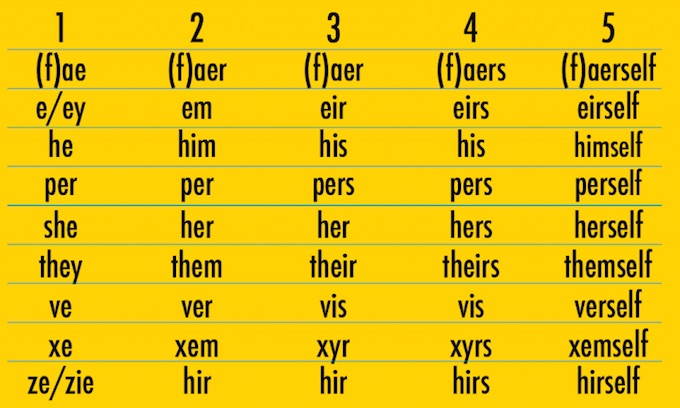 Never say, I’m not looking out for you, my dear Squirrel readers. Today, I bring you the latest in social etiquette so you never offend someone by accidentally referring to them by the wrong pronoun, and then proceed to make it worse by apologizing too earnestly and drawing unwanted attention to them.
Never say, I’m not looking out for you, my dear Squirrel readers. Today, I bring you the latest in social etiquette so you never offend someone by accidentally referring to them by the wrong pronoun, and then proceed to make it worse by apologizing too earnestly and drawing unwanted attention to them.
Here’s your guide to chatting with your LGBTTQQFAGPBDSM friends. Thanks to the University of Wisconsin for clarifying this potentially embarrassing scenario for me.
Some people don’t feel like traditional gender pronouns (she/her, he/him) fit their gender identities. Transgender, genderqueer, and other gender-variant people may choose different pronouns for themselves. The following guide is a starting point for using pronouns respectfully.
How do I know which pronouns to use?
If the person you’re referring to is a stranger or brief acquaintance (like a server, cashier, fellow bus patron, etc), you may not need to know. If the person is a classmate, student, or coworker, for example, it is best to ask. Try:
- “What pronouns do you use?”
- “How would you like me to refer to you?”
- “How would you like to be addressed?”
- “My name is Tou and my pronouns are he and him. What about you?”How often do pronouns change? Remember that people may change their pronouns without changing their name, appearance, or gender identity. Try making pronouns an optional part of introductions or check-ins at meetings or in class.
What if I make a mistake?
Most people appreciate a quick apology and correction at the time of the mistake. Try:
• “Her books are—I’m sorry, hir books are over there.”
By correcting yourself, you’re modeling respectful pronoun use for others in the conversation.
If you only realize the mistake later, a brief apology can help. Try:
• “I’m sorry I used the wrong pronoun earlier. I’ll be more careful next time.”
When should I correct others?
Some people may not want a lot of public attention to their pronouns, while others will appreciate you standing up for them.
If someone uses the wrong pronoun for a person who isn’t present, try a brief correction:
• “I think Sam uses she and her pronouns. And yes, I’m going to her house later too!”
It can be tough to remember pronouns at first. The best solution is to practice! Correct pronoun use is an easy step toward showing respect for people of every gender.

